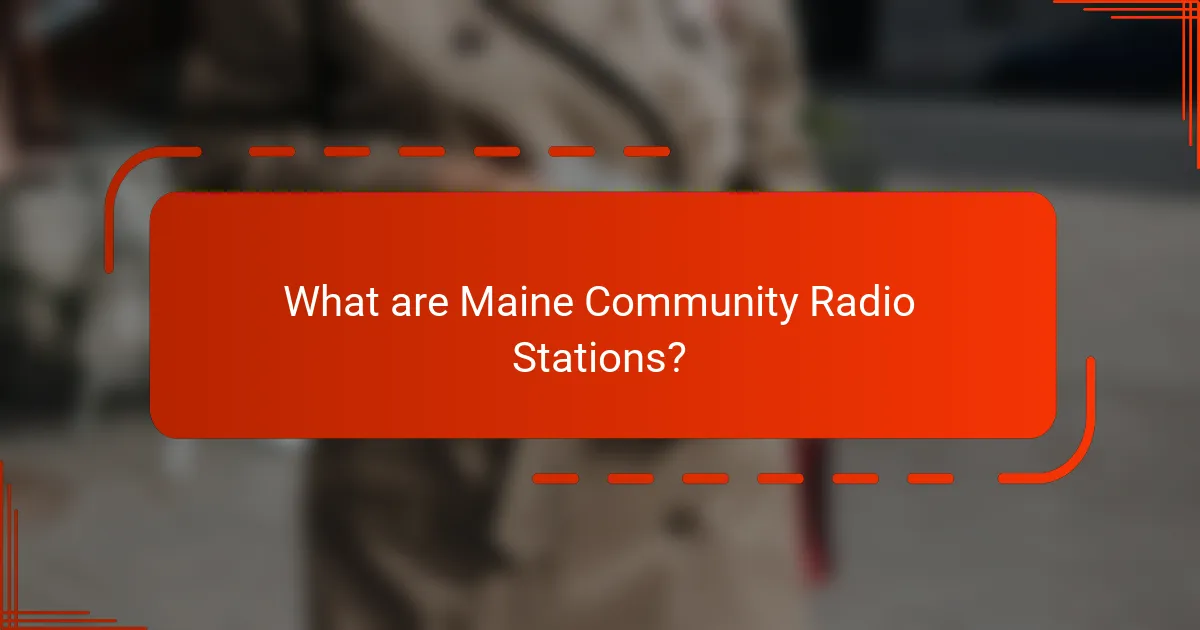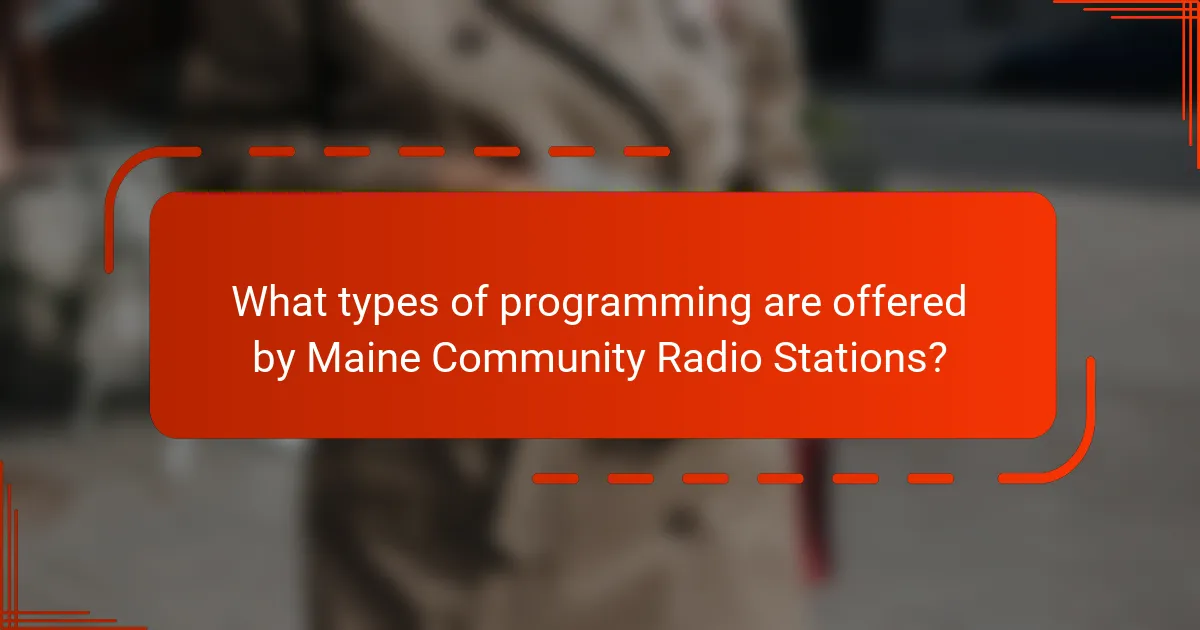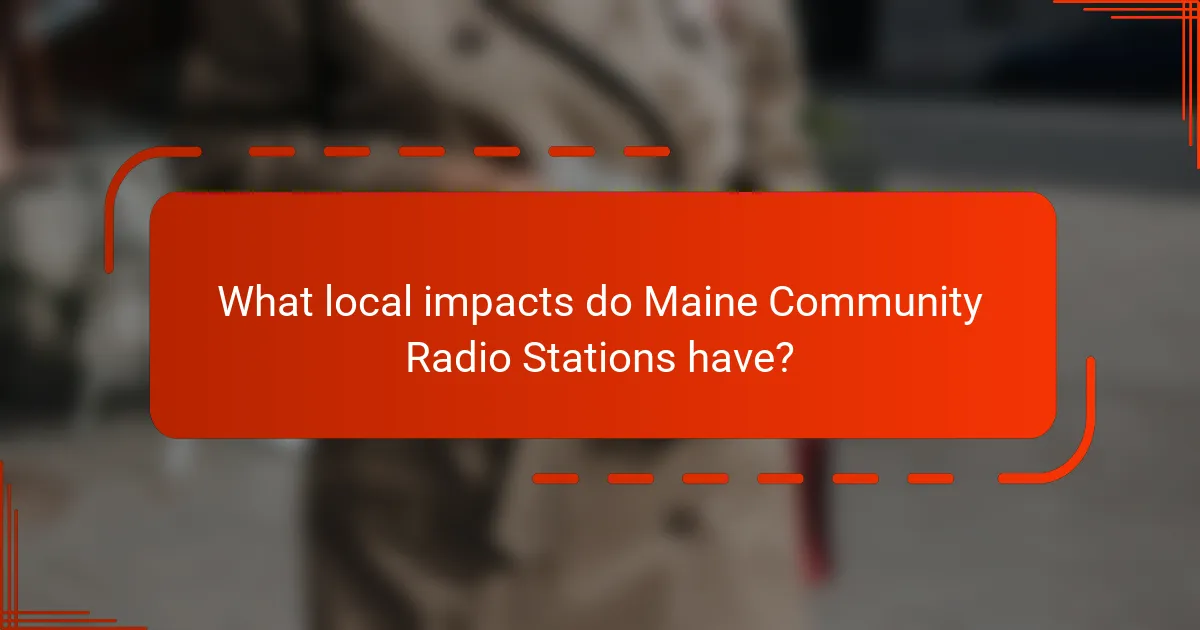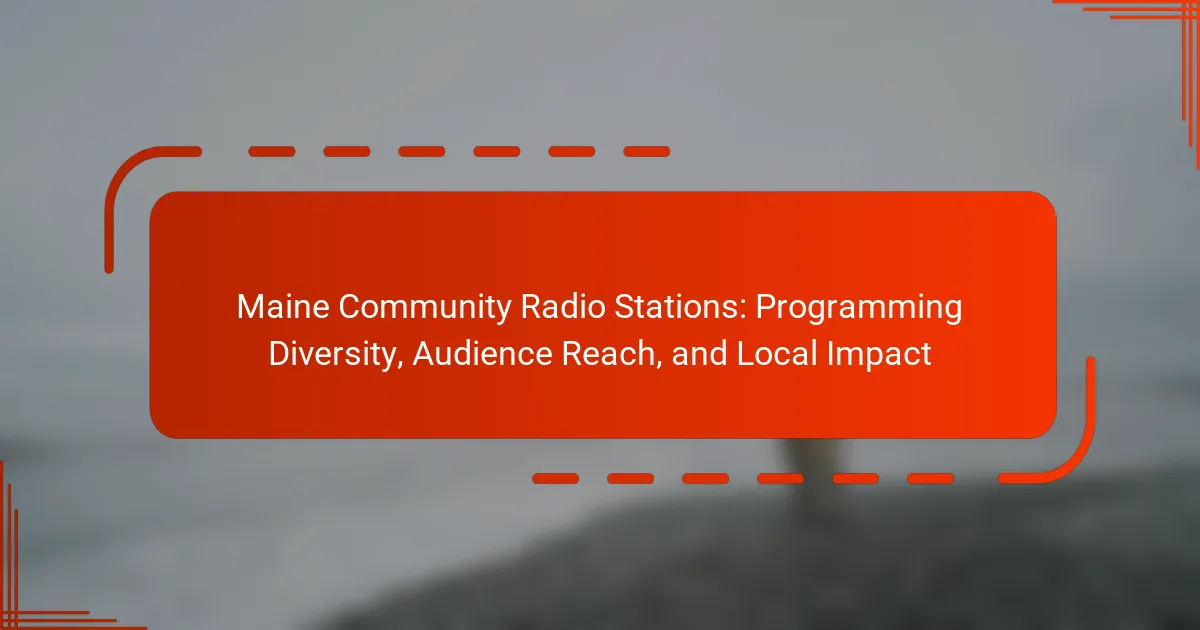Maine Community Radio Stations are non-commercial radio outlets dedicated to serving local communities across the state of Maine. These stations provide diverse programming that includes music, news, cultural content, and community events, often produced by volunteers. With over 30 stations operating in Maine, they play a crucial role in promoting local culture, supporting artists, and offering a platform for underrepresented voices. The stations reach an audience of approximately 50,000 to 100,000 listeners, enhancing local identity and engagement through accessible content and emergency broadcasting. This article will explore the programming diversity, audience reach, and significant local impact of Maine Community Radio Stations.

What are Maine Community Radio Stations?
Maine Community Radio Stations are non-commercial radio outlets that serve local communities in Maine. They provide a platform for diverse programming, including music, news, and community events. These stations are often operated by volunteers and emphasize local content. They foster community engagement and support local artists. According to the Maine Association of Broadcasters, there are over 30 community radio stations in the state. These stations play a vital role in promoting local culture and providing a voice for underrepresented groups. They also serve as a resource for local information and emergency broadcasting.
How do Maine Community Radio Stations operate?
Maine community radio stations operate as non-profit entities focused on serving local audiences. They are typically run by volunteers who manage programming, fundraising, and outreach. These stations often provide a platform for diverse voices and local music. They rely on community support and donations for funding. Many stations offer training for volunteers to develop skills in broadcasting and production. Programming often includes news, talk shows, and music tailored to local interests. According to the National Federation of Community Broadcasters, community radio fosters local engagement and cultural expression. This model allows stations to adapt to the unique needs of their communities.
What is the organizational structure of these stations?
Maine community radio stations typically follow a non-profit organizational structure. This structure often includes a board of directors, which provides governance and strategic direction. Below the board, there are staff members who handle daily operations, including programming, fundraising, and community outreach. Many stations also rely on volunteers for various roles, such as on-air hosts and technical support. This model allows for community involvement and reflects local interests. The non-profit nature ensures that the stations prioritize community service over profit.
How do they source their programming content?
Maine community radio stations source their programming content through a combination of local producers, volunteer contributions, and partnerships with regional organizations. Local producers create original content that reflects community interests and issues. Volunteers often host shows, bringing diverse perspectives and experiences to the airwaves. Additionally, partnerships with educational institutions and non-profits provide access to specialized programming and resources. This collaborative approach ensures a rich variety of content that serves the needs of the local audience.
Why are Maine Community Radio Stations important?
Maine Community Radio Stations are important because they provide a platform for local voices and diverse programming. These stations serve as a vital source of information and entertainment tailored to community needs. They foster local culture by featuring local artists, musicians, and events. Community radio enhances civic engagement by encouraging participation in local issues and discussions. According to the National Federation of Community Broadcasters, community radio stations contribute to media diversity and serve underserved populations. They also create a sense of belonging and identity among listeners. Overall, Maine Community Radio Stations play a crucial role in strengthening community ties and promoting local content.
What role do they play in local communities?
Maine community radio stations play a vital role in local communities by providing accessible information and fostering community engagement. They serve as platforms for local voices, promoting local culture and events. These stations often feature programming that reflects the interests and needs of their communities. They also offer a space for underrepresented groups to share their stories. Research indicates that community radio enhances civic participation and strengthens community ties. According to the National Federation of Community Broadcasters, these stations increase local awareness and connection among residents.
How do they contribute to cultural diversity?
Maine community radio stations contribute to cultural diversity by providing a platform for various voices and perspectives. They broadcast programs that reflect the interests and cultures of local communities. This includes music, news, and discussions that may not be represented in mainstream media. By featuring content in different languages and styles, they promote inclusivity. Research shows that community radio enhances civic engagement and cultural expression. A study by the National Federation of Community Broadcasters indicates that local programming fosters a sense of belonging. This diversity in programming enriches the cultural landscape of Maine.

What types of programming are offered by Maine Community Radio Stations?
Maine Community Radio Stations offer a variety of programming types. These include local news, music shows, and cultural programming. Many stations feature talk shows that focus on community issues. Educational programs are also common, promoting local events and initiatives. Specialty shows may highlight specific genres of music or topics. Some stations provide platforms for youth and community voices. Additionally, there are programs dedicated to public affairs and environmental issues. This diverse programming caters to a wide range of audience interests and needs.
How is programming diversity achieved?
Programming diversity is achieved through a variety of content offerings that cater to different demographics and interests. Community radio stations often include programs in multiple languages to serve diverse populations. They also feature local music, news, and cultural programming that reflect the community’s unique identity. Collaborations with local organizations enhance the range of topics covered. Engaging with community members for feedback helps tailor programming to audience preferences. Surveys and listening sessions can identify gaps in content. Training and support for volunteer hosts encourage diverse voices on air. This approach not only broadens the appeal but also fosters inclusivity within the community.
What genres of music are commonly featured?
Maine community radio stations commonly feature genres such as folk, rock, blues, jazz, and country. These genres reflect the diverse musical tastes of the local audience. Folk music often highlights regional artists and traditions. Rock and blues provide a platform for both classic and contemporary sounds. Jazz showcases local talent and improvisational styles. Country music connects listeners to rural heritage and storytelling traditions. Each genre plays a vital role in community engagement and cultural representation.
What types of talk shows and local news are provided?
Maine community radio stations provide a variety of talk shows and local news segments. Talk shows often feature discussions on local issues, interviews with community leaders, and cultural programming. Local news includes updates on weather, traffic, and events specific to Maine communities. Many stations also cover topics such as health, education, and environmental concerns. These programs aim to engage listeners and promote community involvement. Research shows that local programming fosters a sense of connection among residents.
How do listeners engage with programming?
Listeners engage with programming through active participation and feedback. They tune in to various shows that align with their interests. Many listeners interact via social media platforms, sharing thoughts and comments. Community events often facilitate direct engagement with hosts and other listeners. Surveys and polls are frequently used to gather listener preferences. This feedback helps shape future programming decisions. Research indicates that listener engagement enhances community connection and loyalty. Engaged listeners are more likely to support their local stations financially.
What methods do listeners use to provide feedback?
Listeners provide feedback through various methods. Common methods include phone calls, emails, and social media interactions. Many radio stations have dedicated phone lines for immediate listener responses. Email allows for detailed feedback and suggestions. Social media platforms enable listeners to engage with stations in real-time. Surveys and polls are often conducted to gather listener opinions. Some stations utilize online feedback forms for structured responses. Live events also offer opportunities for listeners to share their thoughts directly. These methods ensure that community voices are heard and considered in programming decisions.
How do community events enhance listener engagement?
Community events enhance listener engagement by fostering personal connections between the audience and the station. These events create opportunities for listeners to interact with hosts and staff. This interaction builds a sense of community and belonging. Research shows that 70% of attendees feel more connected to their local station after participating in events. Additionally, events encourage listener feedback and participation in programming decisions. Engaging listeners in this way leads to increased loyalty and support for the station. Overall, community events serve as a vital tool for enhancing listener engagement and strengthening local ties.

What is the audience reach of Maine Community Radio Stations?
Maine Community Radio Stations typically reach a local audience of around 50,000 to 100,000 listeners. This reach varies depending on the station’s location and broadcast power. Many community stations provide unique programming that attracts dedicated listeners. For instance, stations like WERU-FM serve diverse communities in coastal Maine. According to the Maine Association of Broadcasters, community radio plays a vital role in local media. These stations often engage listeners through local news, music, and cultural programming. Audience surveys indicate that community radio is highly valued for its local content and accessibility.
How do these stations measure their audience?
Maine community radio stations measure their audience through listener surveys and ratings. They conduct regular surveys to gather demographic information and listener preferences. Additionally, stations analyze listener feedback and engagement on social media platforms. Some stations utilize web analytics to track online streaming and website visits. Audience measurement may also include monitoring call-in participation during programs. These methods provide valuable insights into audience size and preferences. Data collected helps inform programming decisions and community outreach efforts.
What demographic information is collected from listeners?
Demographic information collected from listeners typically includes age, gender, income level, education, and geographic location. This data helps radio stations understand their audience better. By analyzing these demographics, stations can tailor their programming to meet listener preferences. For example, younger audiences may prefer different music genres compared to older listeners. Additionally, income levels can influence the types of advertisements that are effective. Geographic location can determine local news coverage and community events featured on air. Collecting this information is essential for enhancing audience engagement and improving content relevance.
How does audience reach impact programming decisions?
Audience reach directly influences programming decisions by determining which content will attract the most listeners. Stations analyze audience demographics and preferences to tailor their programming. Higher audience reach often leads to increased advertising revenue, incentivizing stations to create popular content. For instance, a study by the Pew Research Center shows that stations with a broader audience tend to invest in diverse programming to maintain listener interest. Furthermore, programming decisions are adjusted based on listener feedback and engagement metrics. This data-driven approach ensures that content remains relevant and appealing to the target audience.
What challenges do Maine Community Radio Stations face in reaching audiences?
Maine Community Radio Stations face challenges in audience reach due to limited funding. Many stations operate on tight budgets, restricting marketing efforts. Geographic isolation in rural areas further complicates outreach. Low population density means fewer potential listeners per station. Competition from larger media outlets diminishes visibility. Technological barriers, such as poor internet access, hinder online streaming options. Additionally, aging equipment can limit broadcast quality. These factors collectively impact the ability to engage and grow audiences effectively.
How do technological changes affect listener engagement?
Technological changes significantly enhance listener engagement by providing new platforms and tools for interaction. These advancements enable listeners to access content anytime and anywhere. For instance, the rise of mobile apps allows users to stream live broadcasts on their smartphones. Social media integration fosters real-time conversations between stations and audiences. Data analytics tools help stations understand listener preferences and tailor content accordingly. According to a 2021 report by the Pew Research Center, 61% of Americans listen to radio online, indicating a shift in consumption habits. This shift leads to increased participation in station events and feedback opportunities. Overall, technology facilitates a more interactive and personalized listening experience.
What strategies are used to overcome these challenges?
Maine community radio stations use several strategies to overcome challenges in programming diversity and audience reach. They often collaborate with local organizations to create inclusive content. This partnership approach helps to diversify programming and attract varied audiences. Additionally, stations may implement training programs for volunteers. These programs enhance skills in content creation and broadcasting. Community engagement initiatives are also crucial. Stations host events to connect with listeners and gather feedback. Utilizing social media platforms boosts their outreach efforts. This strategy helps to engage younger demographics and expand their audience base. Furthermore, securing grants and funding supports operational costs and programming diversity. This financial backing enables stations to explore innovative content and technologies.

What local impacts do Maine Community Radio Stations have?
Maine Community Radio Stations significantly impact local communities by fostering engagement and providing a platform for diverse voices. They promote local culture and music, often featuring local artists and events. These stations serve as vital information sources during emergencies and community events. They also encourage civic participation through local news coverage and discussions on relevant issues. According to a study by the National Federation of Community Broadcasters, community radio stations enhance local identity and cohesion. This shows their importance in strengthening community ties and supporting local initiatives.
How do they support local artists and musicians?
Maine community radio stations support local artists and musicians by providing airplay for their music. They often feature local talent in their programming. This includes live performances and interviews with artists. Many stations host events that promote local music. They collaborate with local venues to showcase artists. Additionally, these stations often share information about local music events. This helps to increase visibility for artists. According to a survey by the Maine Association of Broadcasters, community radio significantly boosts local artist exposure.
What initiatives are in place to promote local talent?
Maine community radio stations implement several initiatives to promote local talent. They offer platforms for local musicians and artists to showcase their work. Many stations host live performances and open mic events. These events encourage community participation and engagement. Additionally, radio shows often feature interviews with local creators. This exposure helps build a following for local talent. Stations also collaborate with local organizations to support arts programs. These initiatives create a vibrant local culture and foster talent development.
How do they facilitate community discussions on important issues?
Maine community radio stations facilitate discussions on important issues through local programming and community engagement. They host talk shows that invite listeners to share their opinions. These stations often feature expert guests to provide insights on relevant topics. Community forums and listener call-ins are used to encourage participation. They also broadcast public service announcements that raise awareness about local concerns. Additionally, partnerships with local organizations help address specific community needs. Research shows that community radio enhances civic participation and fosters dialogue among residents. This approach strengthens community ties and encourages informed discussions.
What are the future prospects for Maine Community Radio Stations?
Maine Community Radio Stations are likely to experience growth in audience engagement and programming diversity. As local media continues to evolve, these stations can adapt by utilizing digital platforms. Increased internet access in rural areas also enhances their reach. Community involvement in programming can strengthen local ties. According to the National Federation of Community Broadcasters, community radio serves as a vital source of information and culture. This trend suggests a positive future for these stations, as they fulfill essential local needs.
How can they adapt to changing media landscapes?
Maine community radio stations can adapt to changing media landscapes by embracing digital platforms. They should enhance their online presence through streaming services and social media engagement. This allows them to reach wider audiences beyond traditional radio frequencies. Additionally, they can diversify their programming to include podcasts and on-demand content. Collaborating with local content creators can further enrich their offerings. Regularly assessing audience feedback will help tailor content to listener preferences. Investing in technology and training for staff ensures they remain competitive. These strategies have been effective in maintaining relevance in an evolving media environment.
What best practices can enhance their local impact?
Maine community radio stations can enhance their local impact by fostering strong community partnerships. Collaborating with local organizations increases resource sharing and audience engagement. Hosting community events creates opportunities for direct interaction with listeners. Offering diverse programming that reflects local interests attracts a broader audience. Training volunteers from the community builds local talent and strengthens ties. Utilizing social media effectively promotes programming and events, reaching more potential listeners. Regularly soliciting feedback from the audience ensures that the programming meets community needs. Research shows that stations with active community involvement see increased listener loyalty and participation.
Maine Community Radio Stations are non-commercial radio outlets that serve local communities by providing diverse programming, including music, news, and community events. Operated primarily by volunteers, these stations emphasize local content and foster community engagement while supporting local artists. The article explores the operational structure, programming diversity, audience reach, and significant local impacts of these stations, highlighting their role in promoting cultural diversity and civic participation within Maine communities. Additionally, it addresses the challenges faced in reaching audiences and strategies to enhance local influence and adapt to changing media landscapes.
